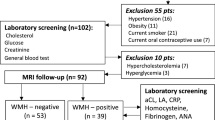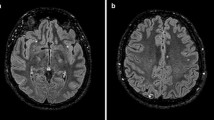Abstract
Migraine has been associated with structural brain damage. Several studies have reported an association between migraine and brain white matter lesions or clinically silent infarct-like abnormalities in the posterior circulation territory. The origin of these lesions is still unclear. The cause is commonly interpreted as ischemic, which is consistent with the association of migraine, particularly with aura, with vascular risk factors. The relationship between increased volume of white matter hyperintensities and a history of severe headache per se is under debate. The clinical relevance of this brain damage deserves further investigations even if an association between cognitive impairment and migraine or headache of any type is not confirmed.


Similar content being viewed by others
References
Kruit MC, van Buchem MA, Launer LJ et al (2010) Migraine is associated with an increased risk of deep white matter lesions, subclinical posterior circulation infarcts and brain iron accumulation: the population-based MRI CAMERA study. Cephalalgia 30:129–136
Kruit MC, Launer LJ, Ferrari MD, van Buchem MA (2006) Brain stem and cerebellar hyperintense lesions in migraine. Stroke 37:1109–1112
Kurth T, Tzourio C (2009) Migraine and cerebral infarct-like lesions on MRI: an observation, not a disease. JAMA 301:2594–2595
Scher AI, Gudmundsson LS, Sigurdsson S et al (2009) Migraine headache in middle age and late-life brain infarcts. JAMA 301:2563–2570
Rozen TD (2007) Vanishing cerebellar infarcts in a migraine patient. Cephalalgia 27:557–560
Rozen TD (2010) Images from headache: white matter lesions of migraine are not static. Headache 50:305–306
Rocca MA, Colombo B, Pagani E et al (2003) Evidence for cortical functional changes in patients with migraine and white matter abnormalities on conventional and diffusion tensor magnetic resonance imaging. Stroke 34:665–670
Rocca MA, Ceccarelli A, Falini A et al (2006) Brain gray matter changes in migraine patients with T2-visible lesions: a 3-T MRI study. Stroke 37:1765–1770
Kim JH, Suh SI, Seol HY et al (2008) Regional grey matter changes in patients with migraine: a voxel-based morphometry study. Cephalalgia 28:598–604
Rocca MA, Pagani E, Colombo B et al (2008) Selective diffusion changes of the visual pathways in patients with migraine: a 3-T tractography study. Cephalalgia 28:1061–1068
Schmitz N, Admiraal-Behloul F, Arkink EB et al (2008) Attack frequency and disease duration as indicators for brain damage in migraine. Headache 48:1044–1055
Kruit MC, Launer LJ, Overbosch J et al (2009) Iron accumulation in deep brain nuclei in migraine: a population-based magnetic resonance imaging study. Cephalalgia 29:351–359
Bousser MG, Welch KM (2005) Relation between migraine and stroke. Lancet Neurol 4:533–542
Welch KM (2003) Stroke and migraine—the spectrum of cause and effect. Funct Neurol 18:121–126
Elkind MS (2008) Endothelial repair capacity and migraine: the fix is in. Neurology 70:1506–1507
Lee ST, Chu K, Jung KH, Kim DH et al (2008) Decreased number and function of endothelial progenitor cells in patients with migraine. Neurology 70:1510–1517
Tietjen EG (2007) Migraine and ischaemic heart disease and stroke: potential mechanisms and treatment implications. Cephalalgia 27:981–987
Scher AI, Terwindt GM, Picavet HS et al (2005) Cardiovascular risk factors and migraine: the GEM population-based study. Neurology 64:614–620
Del Zotto E, Pezzini A, Giossi A et al (2008) Migraine and ischemic stroke: a debated question. J Cereb Blood Flow Metab 28:1399–1421
Anzola GP, Magoni M, Guindani M et al (1999) Potential source of cerebral embolism in migraine with aura: a transcranial Doppler study. Neurology 52:1622–1625
Schwerzmann M, Nedeltchev K, Lagger F et al (2005) Prevalence and size of directly detected patent foramen ovale in migraine with aura. Neurology 65:1415–1418
Adami A, Rossato G, Cerini R et al (2008) Right-to-left shunt does not increase white matter lesion load in migraine with aura patients. Neurology 71:101–107
Park HK, Lee SY, Kim SE et al (2010) Small deep white matter lesions are associated with right-to-left shunts in migraineurs, J Neurol (Epub ahead of print)
Tietjen GE (2009) Migraine as a systemic vasculopathy. Cephalalgia 29:987–996
Igarashi H, Sakai F, Kan S et al (1991) Magnetic resonance imaging of the brain in patients with migraine. Cephalalgia 11:69–74
Tietjen GE, Day M, Norris L et al (1998) Role of anticardiolipin antibodies in young persons with migraine and transient focal neurologic events: a prospective study. Neurology 50:1433–1440
Kurth T, Mohamed S, Maillard P et al (2011) Headache, migraine, and structural brain lesions and function: population based epidemiology of vascular ageing-MRI study. Bmj 342:c7357
Debette S, Markus HS (2010) The clinical importance of white matter hyperintensities on brain magnetic resonance imaging: systematic review and meta-analysis. Bmj 341:c3666
Conflict of interest
The authors declare that there is no actual or potential conflict of interest in relation to this article.
Author information
Authors and Affiliations
Corresponding author
Rights and permissions
About this article
Cite this article
Colombo, B., Dalla Libera, D. & Comi, G. Brain white matter lesions in migraine: what’s the meaning?. Neurol Sci 32 (Suppl 1), 37–40 (2011). https://doi.org/10.1007/s10072-011-0530-7
Published:
Issue Date:
DOI: https://doi.org/10.1007/s10072-011-0530-7




